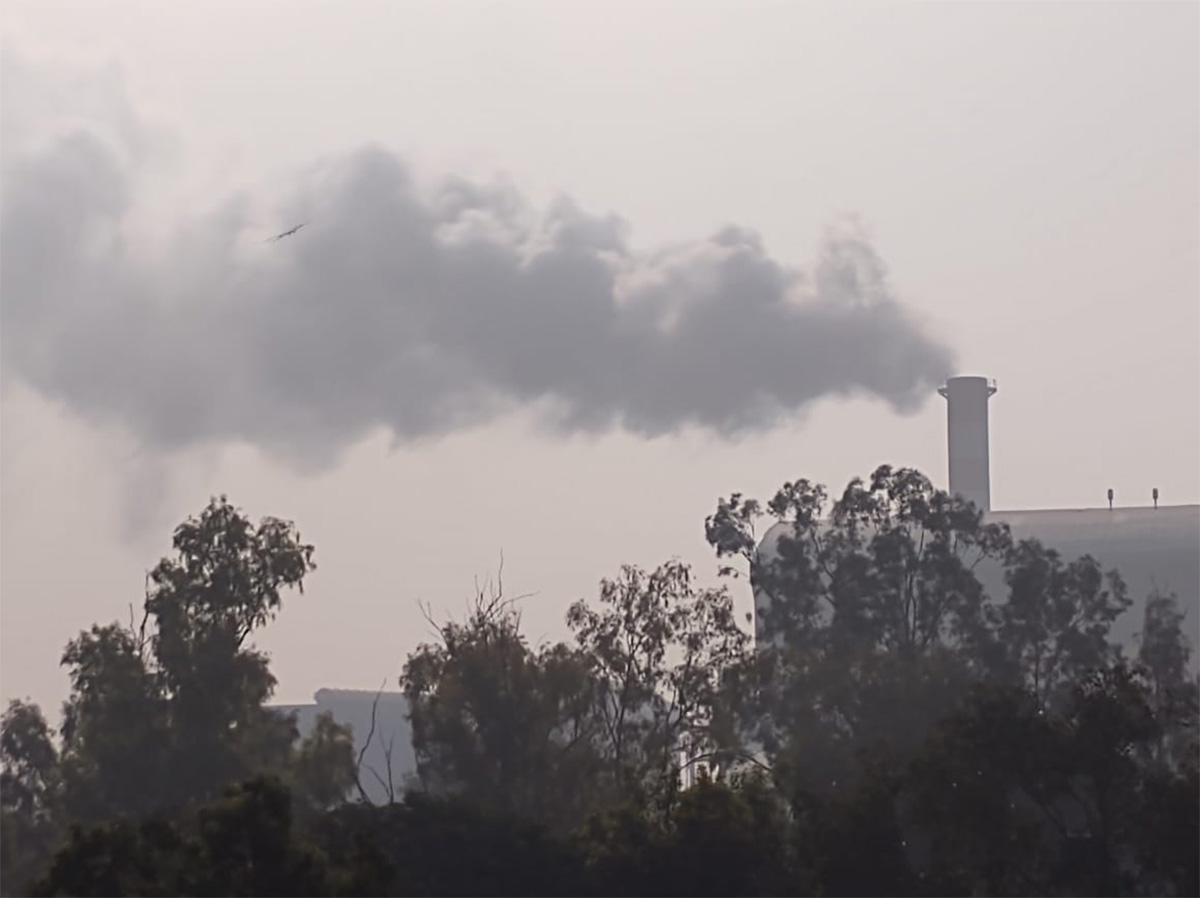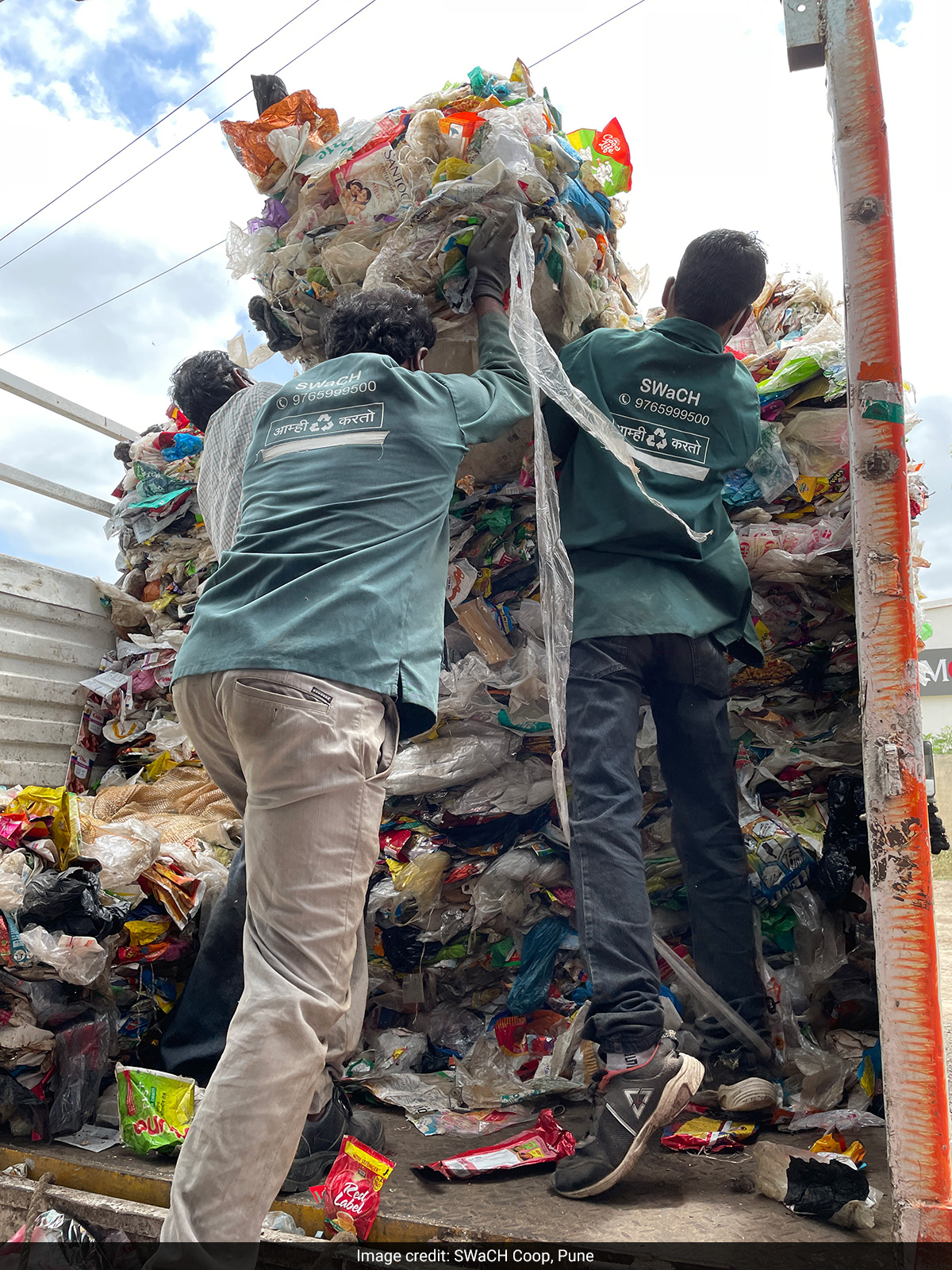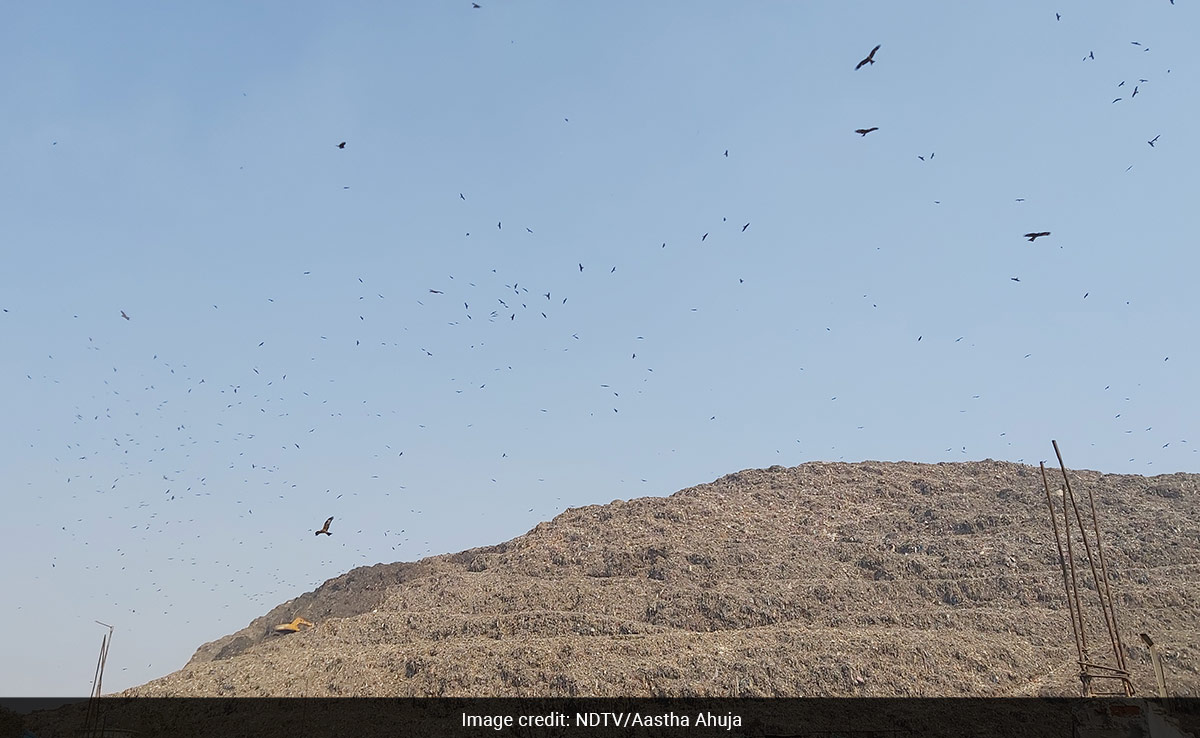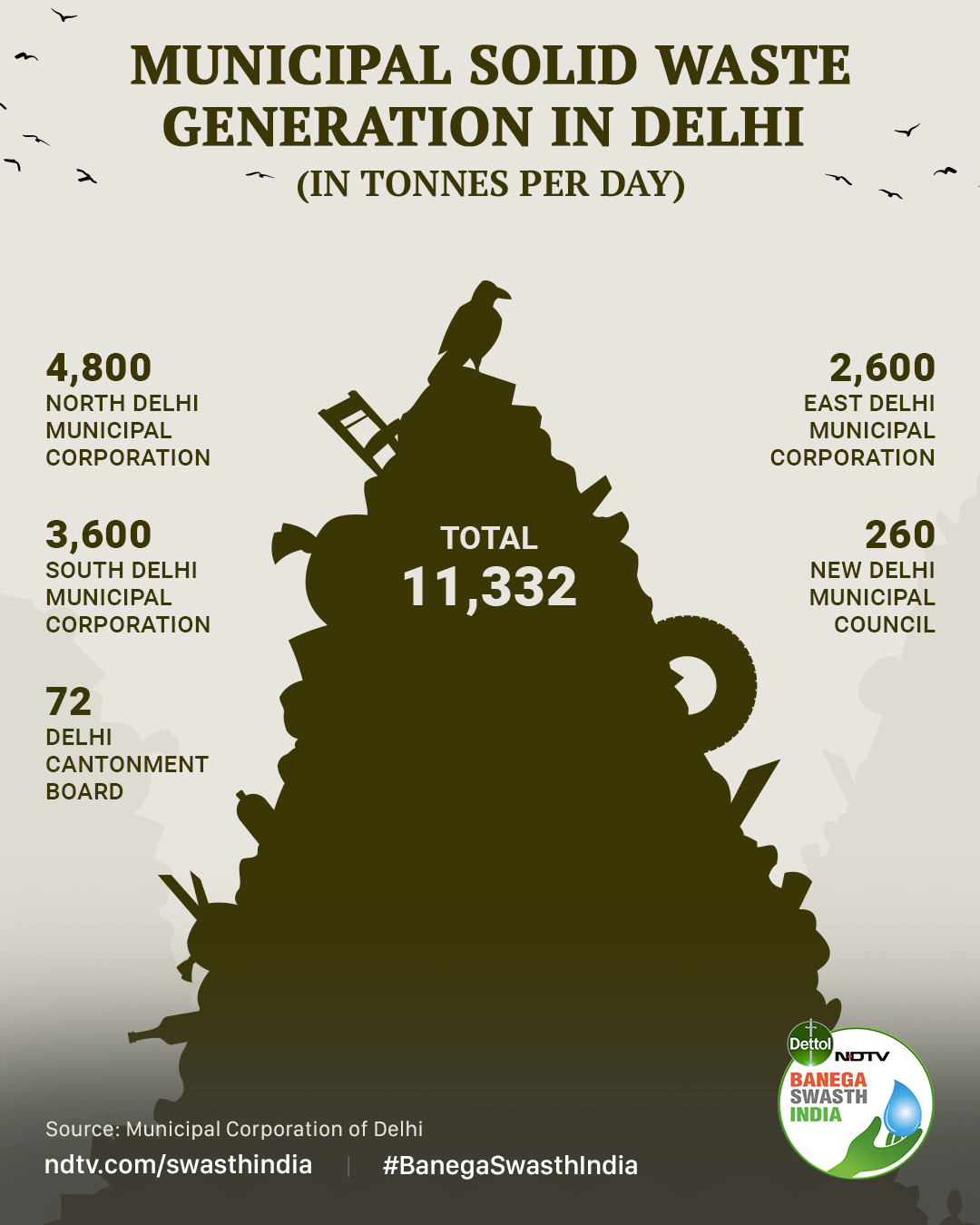NDTV Sites

Delhi’s Garbage Mountains: Affecting Lives And Livelihoods
The National Capital Territory of Delhi is home to over 16 million people, as per the 2011 Census of India. The city is bordered on its northern, western, and southern sides by the state of Haryana and to the east by Uttar Pradesh. Delhi is projected to become the most populous city in the world around 2028, according to United Nations estimates released in May 2018. The projected population size of New Delhi in 2028 is about 37.2 million, surpassing Tokyo’s 36.8 million.
A vast population comes with the challenges of a lack of infrastructure to cope with this surge and its fallout. One of the crises of this ever-growing nature of Delhi is the sheer volume of waste the city generates and its lack of proper disposal. The sprawling metropolitan city is home to three dumpsites – mountains of garbage dotting the landscape of Delhi.
-
Ghazipur
-
Bhalswa
-
Okhla
The three man-made trash mountains in the national capital Delhi
Delhi has three of these manmade mountains. Far from the scenic beauty and breathtaking views associated with hilly terrain, these garbage mountains are an eyesore, emanate stench and are a health and environmental hazard. All three dumpsites are way past their life span, some like Ghazipur by over two decades.
The three dumpsites in Delhi have been ticking time bombs with burgeoning waste. The oldest dumpsite in Ghazipur was commissioned in 1984 and crossed the permissible height of 20 meters in 2002. It has been overflowing since then and stands at around 40 meters, as per the MCD. Similarly, Bhalswa dumpsite, started in 1995, exceeded its capacity in 2006 and Okhla dumpsite commissioned in 1996 was declared exhausted in 2010.
Read More: Living In The Shadows Of Asia’s Largest Garbage Mountain, The Ghazipur Landfill
But of the three dumpsites, Ghazipur (21 years past its life span) and Bhalswa (17 years past its expiry) continue to receive a fresh set of waste every day.
According to the data received from the MCD, 280 lakh tonnes of legacy waste has been dumped on the three dumpsites as of July 2019, with 140 lakh tonnes on the Ghazipur site alone.
As per the information shared by the Municipal Corporation of Delhi (MCD), the city generates 11,332 tonnes of Municipal Solid Waste per day. This includes 11,000 TPD (Tonnes Per Day) from the Municipal Corporation of Delhi (East, South and North Delhi Municipal Corporation), 260 TPD generated by the New Delhi Municipal Council and 72 TPD by the Delhi Cantonment Board.
Of the 11,332 TPD of fresh waste, 6,078.5 TPD is processed at four waste-to-energy plants, 622.4 TPD is processed at composters, biogas plants, organic waste convertors and compost pits, 271 TPD is recycled through 170 Material Recovery Facilities (MRFs). And the remaining 4,360 TPD is disposed of at the dumpsites.


Dumpsites: Health And Environmental Hazard
The Solid Waste Management Rules 2016" define "dump sites" as a land utilised by the local body for the disposal of solid waste without following the principles of sanitary land filling.

"There are barrier layers of high density, polyethylene; mechanisms to collect and treat leachate (contaminated liquid generated when water percolated through waste); collect the landfill gas, which primarily consists of methane and treat that as well. Whereas, when we talk about dumpsites, these are mere pieces of land, which do not have any mechanism for pollution control. We are just dumping the waste haphazardly, over it", said Dr Singh.
On dumpsites, biodegradable or wet waste decomposes over time. The anaerobic decomposition (breakdown of organic waste in the absence of oxygen) of organic waste generates methane gas, which is flammable and generates heat. That's the reason why dumpsites in Delhi, especially in summer, often catch fire. Even if there are not full-fledged fire outbreaks, these sites are always smoldering in patches.
Read More: Landfills: A Big Burden On Delhi’s Chest
According to the data received from Delhi Fire Services, between 2019 and 2022, the Department received 33 fire calls each from Bhalswa and Okhla dumpsite; 23 from Ghazipur.

"Living around dump sites comes with health challenges as people in close vicinity are exposed to gases like the colourless and odorless - Methane, trace gases like H2S (Hydrogen Sulfide), as well as high levels of Particulate Matter and Ammonia. These gases are carcinogenic in nature. Long-term exposure to these gases can result in respiratory disorders, and at times it can lead to cancer as well", said Dr Singh.
In March 2020, the National Green Tribunal (NGT) formed a committee comprising the Central Pollution Control Board (CPCB), National Environmental Engineering Research Institute, and IIT Delhi to prepare a report on the "Assessment of the amount of damage to environment on account of dumpsites in Delhi". As per the report prepared by the joint committee in January 2021, the three dumpsites have collectively caused nearly Rs. 450 crore in damage to the environment. The study assessed the ecological damage due to Bhalswa dumpsite at Rs 155.9 crore, Okhla at Rs 151.1 crore and Ghazipur at Rs 142.5 crore.
Read More: Garbage Mountains – Dotting The Landscape Of Delhi

Waste Workers Living Off The Dumpsites
34-year-old Sheikh Jamshed, who hails from Narghat village in the Medinipur district of West Bengal, has been living off Bhalswa dumpsite for the last 8-10 years. In winters, his work day starts at 4 pm when he walks towards the mountain of garbage and bribes the security guard with a Rs. 20 to enter the dump yard and climb to the top of the trash mountain. With a headlamp around his forehead, Jamshed spends the entire night segregating waste and collecting valuables like PET bottles, plastic reusable containers, milk pouches, tin, metal and plastic bags, among others. At the end of his work shift, he packs all the stuff in a sack and rolls it down the mountain and comes back home by 4am.

Delhi's Bhalswa dumpsite
Jamshed moved to Delhi in 2002 in search of work and ended up having a family and building a house around the Bhalswa dumpsite. He never got the opportunity to dream of a better future.
"Ese sapne gareebo ke liye nahi hote. Jo roz kamata hai, roz khaata hai, uske liye koi sapna nahi hai (Such dreams are not for the poor. People who have a hand to mouth existence don’t have dreams).”
His 16-year-old son, the eldest of the four children, accompanies him to work. When asked what he will do if the dumpsite is brought down in the next few years, he said, “As long as the dumpsite is running, 1,000-1,500 families are surviving. If it gets shut, we will go back to the village.”

Two men climbing the tiny waste hill, popularly known as a landfill in Delhi
Read More: The Human And Health Cost Of Delhi’s Garbage Mountains And Waste Crisis
Delhi relies on a largely informal sector of over 1,50,000 waste workers to collect, segregate and recycle 20-25% of its waste, says Chitra Mukherjee, Consultant, Waste and Sustainable Livelihood.
But today, waste workers’ livelihood is under threat as the entry of fresh waste at two of the dumpsites – Ghazipur and Bhalswa has reduced – and at the third site, Okhla it has come down to zero.
Keeping up with the Solid Waste Management Rules, 2016, the MCD decided to opt for bio-mining of legacy waste. On November 3, 2022, the MCD awarded tenders to three companies to process and dispose of 30 lakh metric tonnes of legacy waste at each of the three sites in 18 months.
Sudhakara Infratech is responsible for managing legacy waste at Ghazipur, GreenTech Environ Management for the Okhla site and Alfa Therm Limited for Bhalswa.

Trommel machine used to segregate the waste into three categories - inert waste, construction and demolition (C&D) waste, and a segregated combustible fraction (SCF)

Waste-To-Energy Plant: A Problem Or A Solution?
Delhi is looking at waste-to-energy plants to treat a chunk of the fresh waste produced by the city. A waste-to-energy plant is a technology that uses waste to generate electricity. Currently, Delhi has four operational waste-to-energy plants at Okhla, Ghazipur, Bawana, and Tehkhand. Together, they process 6078.5 tonnes of fresh waste and 828 tonnes of Refused Derived Fuel (RDF) that comes from the dumpsites. Along with this, two more WTEs are proposed - one at Narela-Bawana and another at Ghazipur. The expansion of existing WTEs at Okhla and Bawana has also been proposed.
As per SWM Rules, only non-recyclable waste with a calorific value of 1500 K/cal/kg or more should be utilised in WTE plants. However, as per the information shared by the MCD, all WTEs in Delhi receive mixed waste.
Read More: Garbage Management Crisis: How Effective Are Waste To Energy Treatment Plants?

“How is this technology going to work in India? We are using a lot of the government’s money on a technology that really doesn’t work in the Indian context. It’s being used because incineration is an easy option. You don’t know what to do with the waste? Just burn it! Instead, we should consider reusing, recycling and composting”, says Ms Mukherjee.
Instead of becoming a solution, WTE plants have become an added problem, as seen in the case of Okhla. The plant is located 35 meters away from 806 DDA SFS Flats of Pocket A and Pocket B of Sukhdev Vihar and is in close vicinity of densely populated colonies of Hajji Colony, Gajar Manjil, and Noor Nagar. The pollution caused by Okhla WTE is such that the doctors are now advising residents to relocate, if possible.

Smoke coming out of Okhla WTE, as captured by a resident of Sukhdev Vihar

How SWaCH, A Cooperative Of Waste Pickers Is Helping Pune Municipal Corporation In Managing Waste
The SWaCH Pune cooperative (jointly established by Pune Municipal Corporation and SWaCH, India's largest cooperative, completely owned by waste pickers), integrates informal itinerant waste-pickers into mostly non-motorised door-step collection, ensuring very high level of segregation at source, collection from slums and streamlined handover of waste to large Feeder vehicles operated by the Pune Municipal Corporation (PMC).
Read More: How A Cooperative Owned By Garbage Pickers Is Solving Waste Management Crisis In Pune
In Pune, each household hands out waste segregated into three primary categories – wet, dry and sanitary waste including sanitary napkins, diapers and condoms. Along with this, thermocol waste is given separately as that is voluminous in nature. After door-to-door waste collection, waste pickers segregate and sort collected waste.
A waste worker segregating milk pouches and plastic bags
Dry waste is divided into categories like plastic bottles, containers, food boxes, plastic bags, and multilayered plastic, among others. Waste pickers recovers valuable waste and sell it to recyclers for livelihood. The non-recyclable dry waste or things like shampoo sachets which can’t be sold are dropped off at Pune Municipal Corporation (PMC) ‘feeder points’.
As per the impact report prepared by SWaCH, PMC saves Rs. 21 crore through waste diversion, Rs. 92 crore in manpower costs.
“Let’s say one waste picker covers 250 houses. 10 will cover 2,500 houses. This way, PMC vehicle collects the waste of 2,500 households from one location,” said Amogh Bhongale, Outreach and Communication Lead, SWaCH Coop Pune.

Waste workers loading multi-layered plastic (MLP) on a truck. The waste will go to recycling
In the absence of waste workers, PMC vehicles would have to make trips and rounds to all these societies leading to more manpower requirement – one person to drive the vehicle and two or three to collect and dump the waste in the van. Then there will be additional fuel consumption.
When recyclables are diverted, it reduces the burden on the city's waste management system; again saving on transportation and processing of waste”, said Mr. Bhongale. Read More: ‘Segregate Menstrual Waste, Mark It With A Red Dot’, Urge Pune Based SWaCH’s Sanitation Workers Dr Ketaki Ghatge, Assistant Medical Officer, PMC shares five key lessons for other cities:
- Create a method for just transition of informal waste workers through integration into formal solid waste management activities of the city
- Providing direct doorstep waste collection service at minimal costs through user fee payments
- Cities can attain highest level of segregation and decentralisation through capacity building of waste workers. Train waste pickers to practice secondary waste segregation and to be able to provide composting services at source
- Decentralised waste management through provision of working spaces/sorting sheds for waste pickers, through ward level composting and bio-methanation plants
- Extended Producer Responsibility is a policy approach in which producers are responsible for management of post-consumer products. Cities should promote just EPR through inclusion of informal recycling sector in management of low value materials like waste pickers in Pune collect thermocol waste or multi-layered plastic











